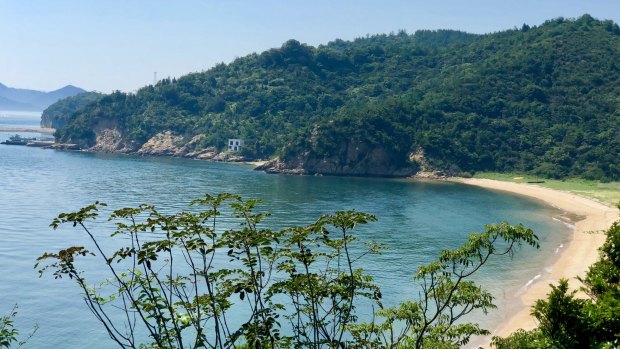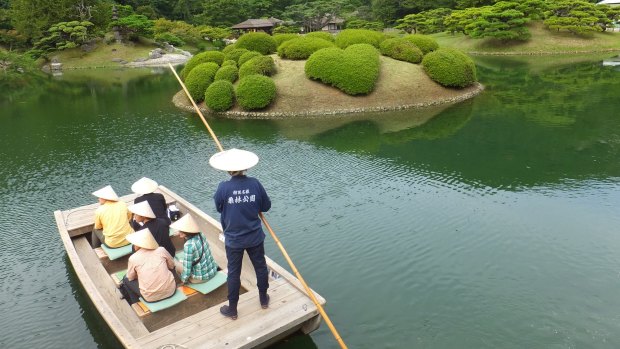This was published 4 years ago
The art islands of Japan that remain one of its best-kept secrets
By Keith Austin

Naoshima.Credit: Charlea Jefts
On the pier next to the ferry terminal on the Japanese art island of Naoshima there is a large, hollow, red-and-black polka-dot pumpkin – one of artist Yayoi Kusama's famous creations. This is also the spot where you catch the bus across the island to the equally well-known Benesse House museum.
The final stop on the route is bookended by another pumpkin. This one is smaller, yellow-and-black, and perched at the end of a seaside jetty. It's a joyous contrast to the natural environment in which it sits and the whole thing is acutely picturesque. At the height of the Setouchi Triennale festival, we are told, the queue to be pictured with it is hundreds of metres long.
On the day we visit, a woman dressed in yellow-and-black polka dots is holding a book on which the yellow-and-black polka-dot pumpkin she's posing next to is pictured. It's so achingly 21st-century meta that I pulled a muscle. In my head.

Takamatsu Ritsurin Garden.Credit: Claire Allison
The Setouchi (pronounced Seto-Uchi) Triennale was started in 2010 in a bid to bring tourism to an area of Japan – the Seto Inland Sea – that was suffering from increasing depopulation. The strategy has worked.
This year's festival is on track to be the most successful yet, with hundreds of thousands of visitors flocking to 12 art islands. The festival features more than 150 works by artists from both Japan and overseas. Imagine Sculpture by the Sea and Hobart's freaky Museum of Old and New Art (MONA) getting together, whelping a 150-strong litter and then distributing the puppies across 12 islands you can only reach by ferry and you've pretty much got the measure of it.
Naoshima is the main – though not the biggest – island and boasts both Benesse House and the Chichu art museum, both of which can be visited any time of any year.
In addition to Naoshima there are 700 or so islands and islets scattered across the area, one of Japan's best-kept secrets despite all the stories that reveal that it's a best-kept secret. Our first glimpse of it comes as our local train rumbles on to the Great Seto Bridge, which connects the mainland's Okayama prefecture to Shikoku Island in Kagawa prefecture.
At 13 kilometres long it's the world's longest double-decker bridge system (at least until October when a similar bridge opens over the Yangtze in China) and it provides breath-taking panoramic views of the island-spattered waters on either side.
Our destination is Takamatsu, the smallish port from which we will take the ferry to Naoshima – an hour-long journey that is part of the attraction as it opens the mind and the heart to the natural beauty of the place quite apart from the art. That's not to say the art isn't spectacular. As are the structures on Naoshima that house it.
The two main buildings – Chichu and Benesse House museums – were created by Tadao Ando, an Osaka-born, self-taught architect whose complex spatial designs appear to be simplicity itself. I'd never heard of him previously but it's interesting to walk around museums that should be in a museum, such are their exquisiteness and strength of purpose.
Chichu was built mostly underground to avoid blighting the natural landscape and followed close collaboration between Ando and artists James Turrell and Walter de Maria, whose permanent, site-specific works form the backbone of the exhibits.
The beauty of the museum, however, is that despite being primarily subterranean it as its website so succinctly puts it, "Lets in an abundance of natural light that changes the appearance of the artworks and the ambience of the space itself with the passage of time".
James Turrell's Open Field is a favourite of mine – an intense experience that plays with light and perception in physically disturbing ways.
The use of natural light is perhaps most evident in the simple whitewashed square where five large artworks in the Water Lilies series by Claude Monet are on display. The room, its size and the amount of natural light that comes in through the roof were all selected to display the paintings at their best. And, of course, as the outside light changes, so does the effect on the paintings.
The same is true of Walter de Maria's Time/Timeless/No Time installation, which consists of an expansive space containing a flight of giants' stairs, a massive granite sphere and 27 gilded wooden geometric forms.
Benesse House is full to overflowing with amazing artworks, and you mustn't leave the island without visiting the once-sleepy fishing village of Honmura, which is now in effect a living art project in which many of the empty or abandoned houses have been turned into artworks. There's also a museum here designed by and devoted to architect Tadao Ando but with his signature use of concrete cleverly hidden inside the bones of one of the village's 100-year-old smoked-cedar-board houses.
Our final experience on the island is quite literally immersive. Before catching the ferry back to Takamatsu, we stop to admire the I Love Yu public bath house, just a block back from Miyanoura port. Part art installation, all onsen, it was designed by Japanese artist Shinro Ohtake in an eclectic scrapbook style using recycled objects.
How could you not? Within minutes I find myself naked except for a small hand towel printed with the words I Love Yu and admiring the large elephant statue which stands on a wall in the middle of the room.
The glass ceiling high above has been brightly painted, large wall tiles depict abalone divers and a giant octopus while smaller tiles on the bottom of the hot bath itself are a collage of ancient Japanese erotica – and not a pumpkin in sight.
TRIP NOTES
Keith Austin was a guest of Inside Japan Tours and Cathay Pacific.
MORE
FLY
Cathay Pacific operates more than 70 flights from various Australian ports to Hong Kong, with onward connections to Japanese cities including Tokyo, Osaka, Sapporo, Nagoya, Fukuoka and Okinawa. .See cathaypacific.com.au
STAY
Inside Japan Tours chooses hotels based on the individual traveller's needs and budget. At Takamatsu we stayed at the JR Clement Inn (not to be confused with the JR Hotel Clement next door), which is a modern hotel next to the train and bus station. Check out the rooftop onsen with views of the city and the sea beyond. See jrclement.co.jp/inn/takamatsu
SEE
This year's Setouchi Triennale is presented in three seasonal sessions over eight months (April 26-May 26, July 19-August 25, September 28-November 4). See setouchi-artfest.jp/en
TOUR
Inside Japan Tours offers small group tours, tailored self-guided adventures and cultural experiences in Japan. See insidejapantours.com
Sign up for the Traveller Deals newsletter
Get exclusive travel deals delivered straight to your inbox. Sign up now.